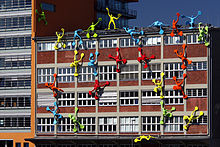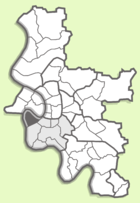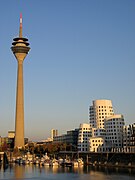Port (Düsseldorf)
|
Port district of the state capital Düsseldorf |
|||
|---|---|---|---|
|
|
|||
| Basic data | |||
| Geographic location : | 51 ° 13 ′ N , 6 ° 45 ′ E | ||
| Height: | 38 m above sea level | ||
| Surface: | 3.79 km² | ||
| Residents: | 130 (December 31, 2016) | ||
| Population density : | 34 inhabitants per km² | ||
| District: | District 3 | ||
| District number: | 033 | ||
| Transport links | |||
| S-Bahn : | S 8 S 11 P 28 | ||
| Tram : | 706 707 | ||
| Bus route: | 723 726 732 | ||
| Night traffic: | NE 8 | ||




Düsseldorf-Hafen is a district of Düsseldorf characterized by industry, logistics, trade and office use with only 130 inhabitants, which corresponds to a population density of 34 inhabitants / km² on a total area of 3.79 km²; thus it is the most sparsely populated of the 50 districts of Düsseldorf . The Düsseldorf commercial harbor, which opened in 1896, occupies a large part of the area; it is the third largest inland port in Germany and part of Neuss-Düsseldorfer Häfen GmbH & Co. KG . The Hafen district belongs to District 3 .
For a long time, the port was not perceived as a district, as this area was a large (partly closed off) industrial area. The rededication of the parts of the port area directly bordering Unterbilk to the so-called "media harbor", which began in the 1990s, and the subsequent redevelopment with partly architecturally ambitious buildings brought the area to the public awareness.
Numerous companies from the media and advertising industry have settled in this area, as well as fashion and designer companies with large exhibition spaces. A multiplex cinema , numerous restaurants, a large discotheque as well as clubs and lounges also ensure a lively nightlife.
history
The beginnings 1886–1913
Before the advent of the railways and trucks , rivers and other waterways were always of paramount importance as a means of transport for goods and people (see also Rhine shipping ). Düsseldorf has been a port city since its foundation, which is also visible in the anchor symbol of its city coat of arms . For centuries ships docked at suitable sections of the bank; in the 17th century a harbor basin was built at what is now Carlstadt . At the beginning of the 19th century , the government of the Grand Duchy of Berg and the city of Düsseldorf built the security harbor (Düsseldorf) along the north side of today's Düsseldorf Art Academy to protect ships from flooding and ice . In the course of the industrialization of the 19th century and a strong population growth, the need to build a large trading port became apparent. The replacement of the Cologne stacking right by the Mainz Act (1831), the founding of the German Customs Association (1834), the emerging steam shipping and the quantities of goods brought in via railways, in particular the products of the rapidly growing heavy industry on the Rhine and Ruhr , made the transport of goods easier the Rhine; the transport volume grew. The establishment of the empire in 1871 gave economy and trade a further boost; the population grew strongly, as did prosperity in many places (see also the founding years ). When discussing where the new port should be located, various locations were considered. Here, the structurally politically active Düsseldorf entrepreneur William Thomas Mulvany first brought up the Golzheimer Insel , then a breakthrough of the Oberkassel peninsula near Heerdt and Lörick through a canal-shaped port. On November 9th, 1886, the city council decided to build a port in the area of the so-called "Lausward", a sub-area of what is now the Hafen district. The soil supplied by the dredging of the harbor basin was used for backfill in the course of the “Rheinufervorschreibung” project in Düsseldorf's old town and for flood protection in the area of Golzheimer Insel. The first port facilities were ceremoniously opened on May 30, 1896. The new port was considered one of the most modern of its time. Its turnover increased sharply; In 1904 and 1907–1909 the area was expanded.
The port entrance is at the so-called Rheinknie south of today's Rheinkniebrücke .
Difficult times 1914–1945
The port suffered badly from the consequences of the First World War , the French occupation (from 1923) and the Great Depression (from 1930). It was not until 1934 that the 1913 figures could be reached again. With the beginning of the Second World War on September 1, 1939, the port was fully integrated into the war economy . It was an important port of entry and exit for the German arms industry; this made it a prime target for bombing raids . After the last bombing in January 1945, freight traffic came to a complete standstill. In April 1945 US troops marched into Düsseldorf .
Reconstruction, boom and crisis 1948–1973
It took almost three years, until the spring of 1948, before the port could again be used for shipping. In 1954 the pre-war level was reached again. The economic miracle of the 1950s also ensured growth in the port of Düsseldorf; At the beginning of the 1960s, the handling volume stagnated. Despite economic losses, the port area was expanded even further until 1964. Many factors (e.g. changes in logistics chains, coal crisis , steel crisis ) contributed to the fact that the port was oversized for the conditions at the time.
Restructuring 1974–1989
In 1974 it was decided to reduce the port area by 33 hectares . The proximity to the old town (about 900 meters as the crow flies) made a rededication of parts of the port for other purposes appear economically interesting. As a result, a concept was developed, on the one hand to guarantee the existing operations site security and on the other hand to develop parts of the port into a modern service and office location in four development steps. The old Berger port had had its day and the basin was filled in. The newly gained area was a welcome green forecourt for the state parliament and the Rhine Tower. It all started with the rededication of the customs port to a marina, the construction of the Rhine Tower (1982), the new building of the Landtag (1988), the construction of the WDR studio in Düsseldorf and the Bilk Rhine Park, the latter in the neighboring suburb of Unterbilk . The second phase began in 1989. According to various council resolutions, a modern office area should be created, including existing buildings and area structures that are worth preserving. It was expected that the creative mix of old buildings with modern architecture would encourage the politically desired settlement of media companies.
Medienhafen from 1990
As a result there was brisk construction activity. At the beginning, for example, Antenne Düsseldorf , the Film- und Medienstiftung NRW and other companies that were more or less part of the media industry settled there. This industry boomed at the beginning of the 1990s due to the privatization of television and radio and was actively promoted by the then state government of North Rhine-Westphalia (Prime Minister: Johannes Rau ). The building complex “ Der Neue Zollhof ” by architect Frank Gehry , completed in 1998/1999, became the flagship of the new location. It soon became apparent that the office space offered was too large to be used exclusively by media companies. The area also became interesting for business consultancies, real estate agents and fashion companies. So sitting in the House of Architects , the Chamber of Architects of North Rhine-Westphalia . In total, the around 600 resident companies offer around 7600 jobs. With around 16% of the rented space, lawyers and consulting firms provide most of the users. Media companies make up only 9% of users. Since the beginning of the 2000s, companies from the fashion industry have also set up shop with sales headquarters and showrooms, including Pepe Jeans London, Tommy Hilfiger , the Sixty Group , Hugo Boss , Tod’s and Guess . Around 40 restaurants, clubs, lounges and a large cinema make the Medienhafen a lively district and a leisure alternative to the old town even in the evening . The herbal liqueur Killepitsch has been produced in the glass factory since 2005 .
The third stage of development also provides for high-quality residential development. This is controversial due to the proximity to the industrial plants in the port.
In the north (near the Rheinturm, for example), the Medienhafen flows smoothly into the government district , which was developed parallel to the Medienhafen project.
Since the beginning of 2014, tram line 719 initially went to the Medienhafen; Since the switch to the new network in February 2016, tram line 707 has served the Medienhafen. For this purpose, new tracks, turning loops and switches were created. The new route leads from the main station through Bilk on the new loop Bilker Church over Gladbacher Straße past the new stop “Speditionstraße” and ends at the stop “Medienhafen, Kesselstraße”.
Neuss-Düsseldorfer Häfen / Düsseldorf industrial port
As a result of the merger with the Neusser Hafen on the other side of the Rhine to form Neuss-Düsseldorfer Häfen GmbH & Co. KG in August 2003, as well as the global economic growth that continued until the end of 2008, the commercial harbor flourished again. The handling of the two opposite ports as well as the port of Reisholz totaled around 14 million tons in 2007. In addition to forwarding agents and logistics companies, the feed manufacturer Deutsche Tiernahrung Cremer GmbH & Co. KG with production and headquarters and Fortin Mühlenwerke GmbH & Co. KG, one of the largest German manufacturers of oat flakes, are represented in the Düsseldorf port area . The company Mosolf Logistics & Services operates a car terminal and carries out regular shipments with its own ships to the seaports. The Lausward power plant is also located here . The industrial companies in the port feel restricted in their development by the development of the media port, as there are hardly any opportunities for expansion. In particular, it is feared that a residential development planned in the Medienhafen could lead to restrictions on emissions from the companies.
Sights and leisure
- Building of the state parliament of North Rhine-Westphalia
- Telecommunications tower " Rheinturm " (next to the new state parliament) with a total height of 240.5 m, a revolving restaurant at a height of 172 m, which turns around itself once an hour. A 160 m high decimal clock shows the time every second in the direction of the old town.
- WDR studio in Düsseldorf
- New Zollhof by Frank Gehry on the current road
- Colorium , a 17-storey high-rise on Speditionstrasse
- Düsseldorf Office Center Kaistraße ( DOCK ), opened on November 27, 2002
- Port Event Center , opened November 27, 2002
- House of Architects , opened on January 8, 2003
- Grand Bateau
- Capricorn house
- SIGN!
- The Roggendorf-Haus with the “Flossis” by the artist rosalie, which were attached on March 9, 2002 and later removed
- The two towers of the Hotel Hyatt Regency Düsseldorf at the Hafenspitze with the pedestrian bridge The Living Bridge over the Medienhafen
The first public golf course in Germany is located near the Lausward power plant . There is also a stretch of beach on the banks of the Rhine to the north of "Bremer Straße", which is a popular destination for excursions and is connected to the Rheinpark Bilk by a pedestrian bridge.
Rheinturm and the eastern media harbor
See also
Neusser Eisenbahn to the railway infrastructure and transport company of the port company
literature
- Hugo Weidenhaupt: Small history of the city of Düsseldorf , Triltsch, Düsseldorf, 9th edition 1983, p. 126, 169, ISBN 3-7998-0000-X .
- The Düsseldorf Atlas , Emons, Cologne 2004, pp. 55, 90f, ISBN 3-89705-355-1 .
Web links
- City of Düsseldorf - Information from the district administration office 03 on the media harbor
- City of Düsseldorf - Information from the city planning office on the Medienhafen
- City of Düsseldorf - Information from the economic development office on the media harbor
- History of the Port of Düsseldorf ( Memento from October 3, 2011 in the Internet Archive )
- MedienHafen.de
- Nightly impressions from the Medienhafen
- Buildings in the media harbor
- 360 ° tour of the Medienhafen by night
Individual evidence
- ^ Office for statistics and elections of the state capital Düsseldorf: Statistics for the district 033 - port
- ↑ Oliver Karnau: The Düsseldorf harbor . In: Studies on Düsseldorf's Economic History , Issue 4, Droste-Verlag, Düsseldorf 1990
- ↑ "Port Expansion". Chronicle: on February 1, 1909, completion and commissioning of the port expansion, see page 305 , in the report on the status and management of community affairs in the city of Düsseldorf for the period from April 1, 1908 to March 31, 1909, p. 305
- ↑ one cause was possibly an unfavorable taxation rule for inland waterway transport
- ↑ Heike Werner, Mathias Wallner: Architecture and History in Germany , Heike-Werner-Verlag, Munich 2006, p. 156
- ^ Port - track construction started for new rail link . In: duesseldorf.de , May 23, 2013 (PDF file)
- ↑ lokalkompass.de
- ^ A b Inauguration of office buildings at the Düsseldorf Medienhafen . In: baunetz.de , November 29, 2002
- ^ Opening of the "House of Architects" in Düsseldorf . In: baunetz.de , January 7, 2003
- ↑ Archive link ( Memento of the original from March 8, 2013 in the Internet Archive ) Info: The archive link was inserted automatically and has not yet been checked. Please check the original and archive link according to the instructions and then remove this notice.













